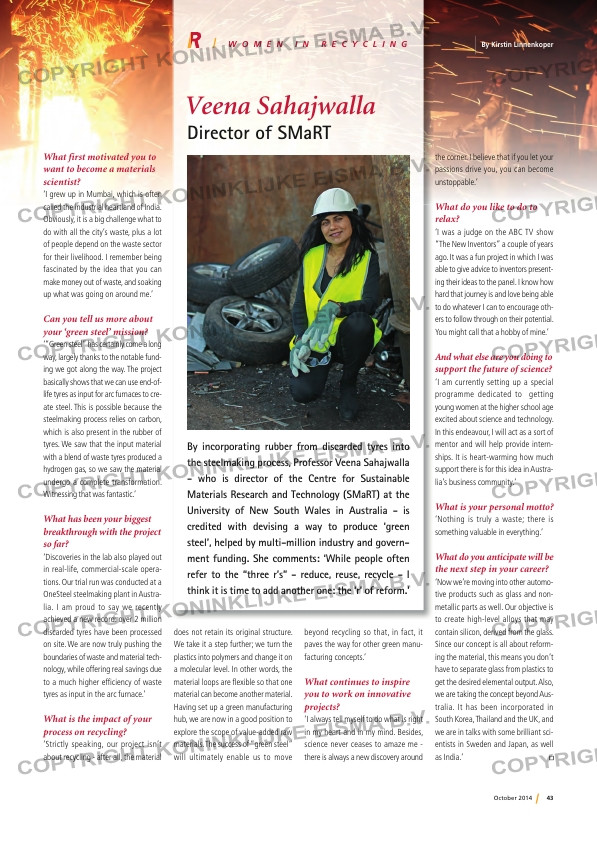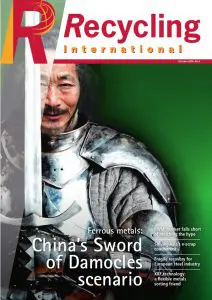Page 43 from: October 2014

43October 2014
By Kirstin Linnenkoper W O M E N I N R E C Y C L I N G
What first motivated you to
want to become a materials
scientist?
‘I grew up in Mumbai, which is often
called the industrial heartland of India.
Obviously, it is a big challenge what to
do with all the city’s waste, plus a lot
of people depend on the waste sector
for their livelihood. I remember being
fascinated by the idea that you can
make money out of waste, and soaking
up what was going on around me.’
Can you tell us more about
your ‘green steel’ mission?
‘“Green steel” has certainly come a long
way, largely thanks to the notable fund-
ing we got along the way. The project
basically shows that we can use end-of-
life tyres as input for arc furnaces to cre-
ate steel. This is possible because the
steelmaking process relies on carbon,
which is also present in the rubber of
tyres. We saw that the input material
with a blend of waste tyres produced a
hydrogen gas, so we saw the material
undergo a complete transformation.
Witnessing that was fantastic.’
What has been your biggest
breakthrough with the project
so far?
‘Discoveries in the lab also played out
in real-life, commercial-scale opera-
tions. Our trial run was conducted at a
OneSteel steelmaking plant in Austra-
lia. I am proud to say we recently
achieved a new record: over 2 million
discarded tyres have been processed
on site. We are now truly pushing the
boundaries of waste and material tech-
nology, while offering real savings due
to a much higher effi ciency of waste
tyres as input in the arc furnace.’
What is the impact of your
process on recycling?
‘Strictly speaking, our project isn’t
about recycling – after all, the material
does not retain its original structure.
We take it a step further; we turn the
plastics into polymers and change it on
a molecular level. In other words, the
material loops are fl exible so that one
material can become another material.
Having set up a green manufacturing
hub, we are now in a good position to
explore the scope of value-added raw
materials. The success of “green steel”
will ultimately enable us to move
beyond recycling so that, in fact, it
paves the way for other green manu-
facturing concepts.’
What continues to inspire
you to work on innovative
projects?
‘I always tell myself to do what is right
in my heart and in my mind. Besides,
science never ceases to amaze me –
there is always a new discovery around
the corner. I believe that if you let your
passions drive you, you can become
unstoppable.’
What do you like to do to
relax?
‘I was a judge on the ABC TV show
“The New Inventors” a couple of years
ago. It was a fun project in which I was
able to give advice to inventors present-
ing their ideas to the panel. I know how
hard that journey is and love being able
to do whatever I can to encourage oth-
ers to follow through on their potential.
You might call that a hobby of mine.’
And what else are you doing to
support the future of science?
‘I am currently setting up a special
programme dedicated to getting
young women at the higher school age
excited about science and technology.
In this endeavour, I will act as a sort of
mentor and will help provide intern-
ships. It is heart-warming how much
support there is for this idea in Austra-
lia’s business community.’
What is your personal motto?
‘Nothing is truly a waste; there is
something valuable in everything.’
What do you anticipate will be
the next step in your career?
‘Now we’re moving into other automo-
tive products such as glass and non-
metallic parts as well. Our objective is
to create high-level alloys that may
contain silicon, derived from the glass.
Since our concept is all about reform-
ing the material, this means you don’t
have to separate glass from plastics to
get the desired elemental output. Also,
we are taking the concept beyond Aus-
tralia. It has been incorporated in
South Korea, Thailand and the UK, and
we are in talks with some brilliant sci-
entists in Sweden and Japan, as well
as India.’
By incorporating rubber from discarded tyres into
the steelmaking process, Professor Veena Sahajwalla
– who is director of the Centre for Sustainable
Materials Research and Technology (SMaRT) at the
University of New South Wales in Australia – is
credited with devising a way to produce ‘green
steel’, helped by multi-million industry and govern-
ment funding. She comments: ‘While people often
refer to the “three r’s” – reduce, reuse, recycle – I
think it is time to add another one: the ‘r’ of reform.’
Veena Sahajwalla
Director of SMaRT
RI8-Women in RI.indd 43 06-10-14 14:03



